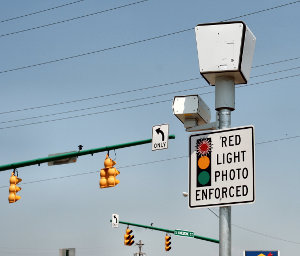
Crews began installing Rochester’s new red light cameras this week. The cameras will eventually cover 50 city intersections, and will automatically catch vehicles running red lights and issue $50 tickets to their owners. The system, originally proposed back in April, 2009, will cost $3,750/month/camera to operate. Meanwhile, the city is projecting $3.5m in revenue from tickets issued. Crunch that up, and we are looking at about $1.25m to the city’s bottom line as a result of this program. Yet Mayor Duffy says, “This is about safety. It’s not about revenue.”
Police Chief David Moore stated, “We feel very strongly this will help keep motorists and pedestrians safe in our community.” Further, the city says that 2,498 of the 6,030 crashes in 2009 happened at intersections. And YNN News reports on the extremely graphic public service announcements running lately in an effort to make citizens aware of the danger of running red lights.
However, there is another side to this story that has gone all but untold by the local media. While no one is claiming running red lights isn’t dangerous, there is ample data showing that not only are there better solutions to the problem, but that red light cameras actually increase accidents at intersections because people try to speed up and beat the yellow or slam on the breaks causing rear-end collisions.
Six different studies from Australia, Virginia, North Carolina, Ontario, Canada, Washington D.C., and the U.S. Congress each conclude that red light cameras cause accidents.
From the June, 2007 Virginia Transportation Research Council study:
“After cameras were installed, rear-end crashes increased for the entire six-jurisdiction study area… After controlling for time and traffic volume at each intersection, rear-end crash rates increased by an average of 27% for the entire study area.”
From the July, 2004 North Carolina Agricultural & Technical State University Study:
“The results do not support the view that red light cameras reduce crashes. Instead, we find that RLCs are associated with higher levels of many types and severity categories of crashes.”
An October, 2005 analysis by the Washington Post found that D.C. red light cameras resulted in a doubling of crashes at RLC equipped intersections. This included a 30% increase in broadside collisions and an 81% increase in injuries/fatalities.
RLCs have an intuitively positive effect, but the data simply does not bear them out as an effective deterrent. Quite the opposite, RLCs are a proven road hazard. So where do all the safety claims come from? A May, 2001 study by former House Majority Leader Dick Armey’s staff found the following:
“Every study claiming red light cameras increase safety is written by the same man. Before joining the Insurance Institute for Highway Safety (IIHS), he was a top transportation official in New York City at the time the city began looking into becoming the first jurisdiction in the country to install red light cameras. In other words, the father of the red light camera in America is the same individual offering the “objective” testimony that they are effective.”
More recently, the public interest group called “National Campaign to Stop Red Light Running” has been very active in lobbying municipalities to install RLC systems in the name of safety. They provide much of the data used to defend the safety assertions and are often the objective source of data cited by local governments petitioning to purchase RLC systems. However, while this group positions itself as an influential, “independent” authority on one of the major causes of traffic accidents, it is actually a well orchestrated lobby funded almost entirely by manufacturers of red light cameras.
To add insult to the injury caused by RLCs, it has been shown that simply lengthening the duration of the yellow light in intersections results in fewer crashes. A January, 2009 report on an experiment in Denver showed that making yellow lights 4 or 5 seconds instead of 3 seconds resulted in an order of magnitude reduction in red light violations each day.
The Federal Highway Administration was cited as complicit by Dick Armey’s staff in their report:
“And one should ask the question, if there’s a problem with an intersection, why don’t safety engineers in the field just go out and fix the timing?
In fact, before red light cameras arrived in the United States, that’s exactly what our regulations instructed them to do. If too many people enter on red at an intersection, engineers were supposed to lengthen its yellow time. But in the year that red light cameras first started collecting millions in revenue on our shores, those entrusted with developing our traffic safety regulations dropped the requirement to fix signal timing, instructing engineers to “use enforcement” instead.
Indeed, according to the Federal Highway Administration, these problem intersections serve as a great location to hold a press conference. The agency offers a script for local officials to exploit a tragically mistimed intersection to call for the installation of additional red light cameras and tout their safety benefits.”
In other words, the safety touted by red light cameras is available for cheap by simply adjusting the light timing at intersections. Instead, we are deploying systems that sound good, but are shown to make the problem worse, and pad the city’s coffers in the process.
Mayor Duffy is free to claim this isn’t about revenue, but the evidence disagrees with him.

One thought on “The real story behind Rochester’s new red light district”